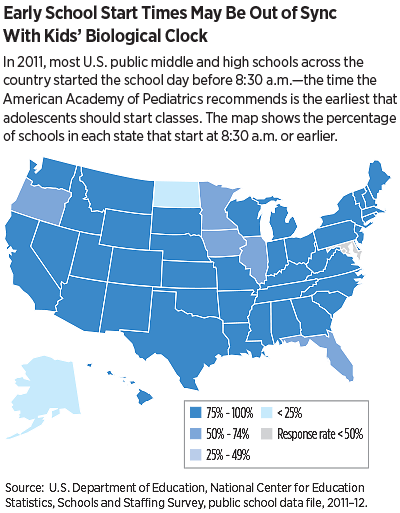Early Start Times at U.S. Schools May Cause Teens to Lose Sleep
Abstract
Students with depression, anxiety, and other mental disorders may be vulnerable to the stress of chronic sleep loss, which can lead to a worsening of symptoms.
The nation’s schools start too early for most teenagers, according to researchers at the Centers for Disease Control and Prevention (CDC) and U.S. Department of Education.
The average start time of U.S. public middle and high schools is 8:03 a.m., the researchers reported in the August 7 Morbidity and Mortality Weekly Report.
Only 17.7 percent of public middle and high schools in the United States start at 8:30 a.m. or later, as the American Academy of Pediatrics (AAP) recommended in a policy statement issued in 2014.

Early school start times are out of sync with the adolescent biological clock, which prompts teenagers not to become sleepy until 11 p.m. or later and to sleep until 8 a.m. or later. Most adolescents need 8.5 to 9.5 hours of sleep for full alertness. Two-thirds of high school students, however, usually sleep less than eight hours on school nights.
Previous studies show insufficient sleep increases adolescents’ risks for poorer classroom performance, depression, excess weight, inactivity, and use of alcohol, tobacco, and illicit drugs. It also boosts risks for sports injuries and drowsy-driving crashes.
To assess state-specific distributions of public middle and high school start times, Anne Wheaton, Ph.D., an epidemiologist in the CDC’s Division of Population Health, and colleagues analyzed data from about 8,000 public middle, high, and combined schools in the United States that responded to the Department of Education’s 2011-12 Schools and Staffing Survey. These schools are representative of an estimated 39,700 U.S. public schools with a total enrollment of more than 26 million students.
School start times varied considerably by state. No schools in Hawaii, Mississippi, or Wyoming started at 8:30 a.m. or later, while more than 75 percent of schools in Alaska and North Dakota did so. Students in Louisiana schools had the earliest average start time, with classes beginning at 7:40 a.m. In 42 states, at least 75 percent of schools started before 8:30 a.m. To make these early starts, students in some states must rise before 5 a.m. and board school buses at 6 a.m. or earlier.
“Among the possible public health interventions for increasing sufficient sleep among adolescents,” Wheaton’s team said, “delaying school start times has the potential for the greatest population impact.” School start times typically are set locally by school districts or individual schools.
In the three years since the information cited in the CDC report was collected, schools in a few communities have shifted to later start times, but most schools still start too early, Judith Owens, M.D., director of sleep medicine at Boston Children’s Hospital and chair of AAP’s Adolescent Sleep Working Group, told Psychiatric News. Planning and implementing start time changes may take years, she said.
Assuring that adolescents obtain sufficient sleep has particular import for psychiatrists, she noted. In students with depression, anxiety, and other mental disorders, the stress of chronic sleep loss can increase both symptoms and severity. “Psychiatrists,” she asserted, “can be powerful voices of advocacy for healthier school start times in their communities.” ■
“School Start Times for Middle School and High School Students—United States, 2011–12 School Year” can be accessed here.



